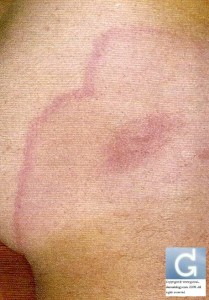Lyme Disease (Borreliosis)
Lyme disease, what is it?
- Lyme disease (also called Borreliosis) is a systemic disease with skin manifestations.
- It is caused by bacteria of the Borrelia family which is transmitted via a tick bite (tick of the Ixodes family).
- The name Lyme disease refers to “Old Lyme”, a town in Connecticut in the United States where the disease was described for the first time.
How is Lyme disease caught?
- The bacteria responsible for Lyme disease is present around the world but is frequent in Europe and North America.
- The bacteria is transmitted by ticks, which contaminates humans through bites.
How to avoid getting Lyme disease?
- The best is to avoid getting bitten by ticks. Many other infections can be transmitted by other insects and by preventing tick bites, other insects can be prevented from reaching the skin.
- To learn more about preventing tick bites, click here
- If you notice a tick bite, do not worry, but it is important to remove the tick. The best is to consult a medical doctor without delay. He/her will document the time of the bite, remove the bite, and may give you a unique dose of antibiotics.
How does early Lyme disease present itself on the skin?
- Often, a red ring appears at the level of the bite and growns centrifugally (away from the center (centre)) (erythema chronicum migrans) (early localised phase).
- multiple erythema chronicum migrans (rare in Europe) and/or extracutaneous manifestations: joints, heart, nervous system, eye…(early disseminted phase).
- Lymphocytoma is more frequent in children and present as red nodules on the face, lobules of the ears, the trunk and more rarely the genital area.
- The diagnosis is clinical and can be completed by positive serologies in the blood or PCRs (poymerase chain reaction) on skin samples. Curative treatment consists of taking oral antibiotics. However, treatment by injection will be needed if the nervous system is involved.
How does Lyme disease present in the late phase?
- involvement of the nervous system
- involvement of the joint
- heart involvement
- skin involvement: violaceous atrophy of the extremities (acrodermatitis chronicum atrophicans).
- Diagnosis relies on clinical clues, but the results of blood tests is less reliable. Showing the presence of the bacteria by PCR (polymerase chain reaction) or is reliable.
- Treatment of the late phase is by injecting antibiotics intraveinously.
Is the probability of neurological and articular involvement the same according to where I was bitten?
- No, joint involvement is more frequent in the United-States whereas nervous system involvement (neuroborreliosis) is more frequent in Europe.
Category : acrodermatite chronique atrophiante - Modifie le 06.7.2010Category : acrodermatitis chronica atrophicans - Modifie le 06.7.2010Category : borréliose - Modifie le 06.7.2010Category : borreliosis - Modifie le 06.7.2010Category : erythema chronicum migrans - Modifie le 06.7.2010Category : lyme disease - Modifie le 06.7.2010Category : lymphocytoma - Modifie le 06.7.2010Category : lymphocytome cutané bénin - Modifie le 06.7.2010Category : maladie de lyme - Modifie le 06.7.2010



